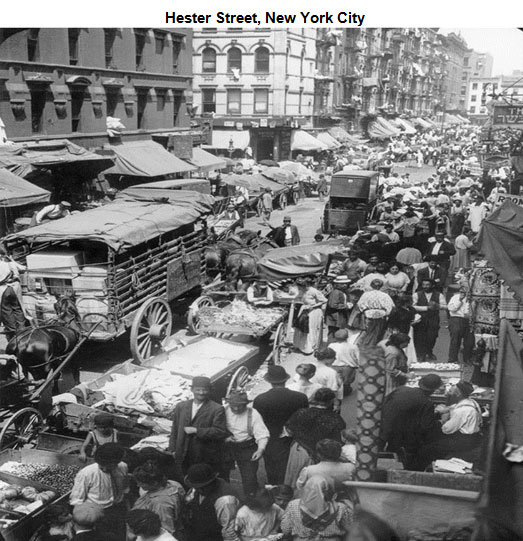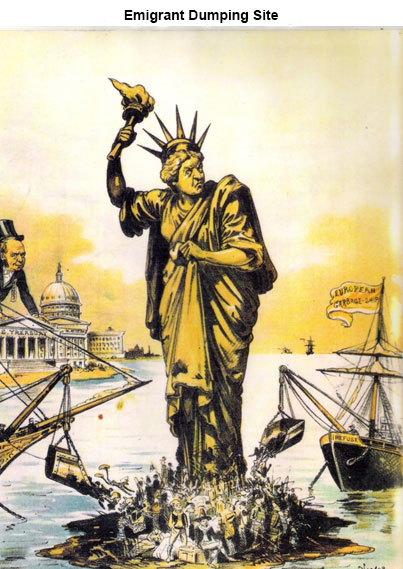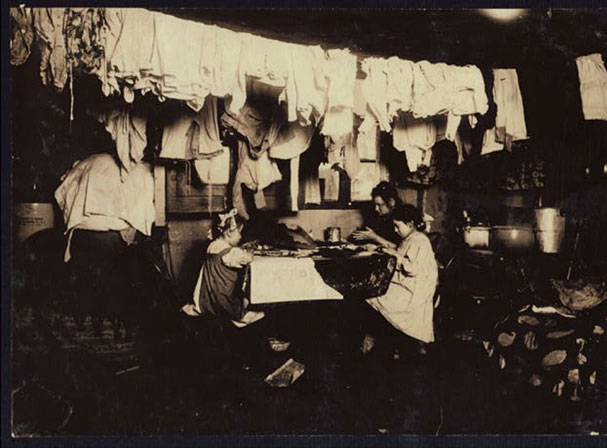
Source: Hester Street-New York City, Unknown Photographer, National Archives

Source: Hester Street-New York City, Unknown Photographer, National Archives
The photo above was taken in the early 1900s. What words would you use to describe the scene on this street? Overcrowded? Chaotic? Both terms may fit perfectly. The photo is of Hester Street, an open-air street market, where people could find all kinds of goods. The overcrowded streets are an indication of how much the urban population had grown as a result of the Gilded Age.
There were several social issues that plagued American society during the Gilded Age. Many of those issues were the result of increased immigration in the United States and the migration of Americans from rural areas to large cities. As word of new job opportunities in America spread to foreign countries, immigration rapidly increased. Most immigrants at this time came from southern and eastern Europe. Many immigrants also came from Ireland.
Typically, immigrants moved into areas that were populated by people of the same race or ethnicity. This led to the creation of ethnic neighborhoods. These ethnic neighborhoods could be found in cities such as New York City, Pittsburgh, or Chicago.
Not everyone had a positive attitude about immigrants coming to America. Many nativists felt that the flow of immigrants posed a threat to American society. Since the 1840s, nativists had embarked upon a campaign to protect the rights of native citizens of America against those of immigrants.
To spread their beliefs, nativists started a cartoon campaign to express their beliefs about immigration. The cartoon below, “Dumping European Garbage,” was a part of this campaign. Carefully analyze the cartoon and answer the questions that follow in your notes.

Source: Dumping European Garbage, In the Past Lane
Analyzing the Cartoon - The Statue of Liberty was frequently used in the nativists’ cartoon campaign. What does the Statue of Liberty symbolize? Why do you think this was a significant symbol in their campaign?

The combination of mass immigration to major U.S. cities and increased rural migration to urban areas led to rapid population growth in these areas. This urbanization caused a housing shortage, which made for overcrowded, poor living conditions for many people who moved into these areas.
To accommodate the overpopulation and influx of immigrants, people lived in tenements. These were sometimes former single-family apartments that were divided to provide space for multiple families. These buildings were overcrowded with poor ventilation and inadequate plumbing. The neighborhoods became unsanitary and some became slums.

Source: NcLc.04133, Lewis Hine, Library of Congress
Photographer Jacob Riis toured these areas and documented the living conditions of the poor working class through photography. Riis documented the lives of the poor in his book titled How the Other Half Lives.
During the Gilded Age, a growing number of Americans worked in urban areas in manufacturing factories. They worked 10-hour shifts, six days a week. The wages they earned were barely enough to support their families. Adults worked long and hard and sometimes they were injured as a result of their jobs. Those who were injured on the job, or otherwise unable to work, were simply replaced by another worker. There was little to no job protection for workers during this time.
Eventually, workers decided that these conditions were no longer tolerable. Realizing that laborers outnumbered owners, laborers began to organize and develop labor unions. Labor union members participated in strikes as a means to evoke change from the business owners.
Labor union members were met with intimidation and sometimes violent resistance from the bosses and owners. However, the reaction from the business owners did not deter the labor unions. The labor union movement grew slowly as members fought for safer working condition, higher wages, and shorter work hours.
Another issue that impacted the labor force was child labor. Children worked in factories, carrying out tasks that were sometimes extremely dangerous. Children, some as young as eight years old, went to work instead of attending school. They were often expected to do the same work as adults did, but for less pay.
![]() Click on each image below to read an excerpt from Lewis Hine’s photo description of each photo.
Click on each image below to read an excerpt from Lewis Hine’s photo description of each photo.
Think about what you have learned about child labor and answer the following questions in your notes.
Interactive popup. Assistance may be required.
Children who worked during the Gilded Age were able to contribute to the family’s finances. These children were also able to learn minimal labor skills.
Interactive popup. Assistance may be required.
Most children who worked during the Gilded Age were not able to attend school. Child laborers worked on jobs that posed a danger to their safety. Children were often paid less for performing the same jobs as the adults.
Sources for images used in the interactive: